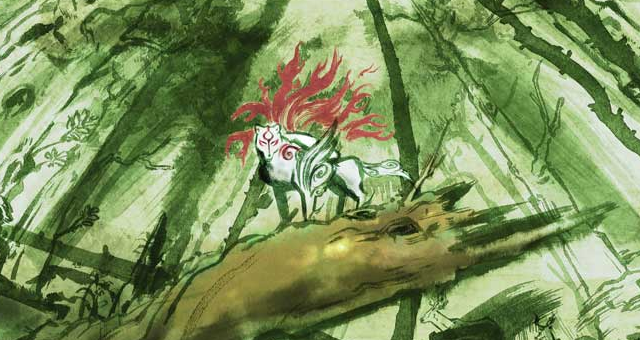 Despite not being an even number, there’s just something that feels right about the number three. Plays regularly have three acts, stories have a beginning, a middle and an end, and trilogies abound across all forms of media, not least in games. And so it is that we come to the third and final part of our tour through Ōkami‘s hidden myths and legends. Even more fittingly, this time we’ll focus on the third and concluding arc of Amaterasu’s quest when she finds herself drawn to the northern island of Kamui and the wolfish Oina tribe.
Despite not being an even number, there’s just something that feels right about the number three. Plays regularly have three acts, stories have a beginning, a middle and an end, and trilogies abound across all forms of media, not least in games. And so it is that we come to the third and final part of our tour through Ōkami‘s hidden myths and legends. Even more fittingly, this time we’ll focus on the third and concluding arc of Amaterasu’s quest when she finds herself drawn to the northern island of Kamui and the wolfish Oina tribe.
But here’s where we depart slightly from the first and second parts of this mythological retrospective and take our cues from the folklore of the Ainu rather than the Japanese. Just in case you’re unfamiliar with the Ainu, let me give you a quick run down of their history.
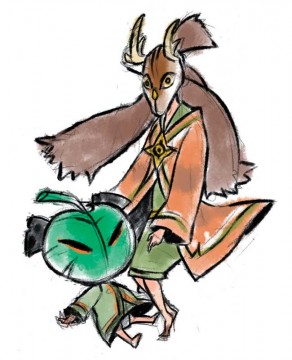 The Ainu, or Ezo, are an indigenous group of people native to what’s now known as Hokkaido, the northern most region of Japan, as well as the Kuril Islands and much of Sakhalin, both of which are now part of Russia. The number of Ainu now living is unknown, but they have their own language and their culture dates back to 1200 AD. They’re traditionally animists, believing that everything in nature has a “kamui” (spirit or god) living inside them. There’s also a hierarchy to these kamui, the most important being Grandmother Earth (fire), with Kamui of the Mountain (animals) and Kamui of the Sea (sea animals) following.
The Ainu, or Ezo, are an indigenous group of people native to what’s now known as Hokkaido, the northern most region of Japan, as well as the Kuril Islands and much of Sakhalin, both of which are now part of Russia. The number of Ainu now living is unknown, but they have their own language and their culture dates back to 1200 AD. They’re traditionally animists, believing that everything in nature has a “kamui” (spirit or god) living inside them. There’s also a hierarchy to these kamui, the most important being Grandmother Earth (fire), with Kamui of the Mountain (animals) and Kamui of the Sea (sea animals) following.
As you can see, these small details alone already shed a lot of light on the origins of Ōkami‘s Oina tribe. Each member has their own animal headdress, their island is named after the Ainu kamui, and they live in the most northern region of Nippon. The Ainu’s alternative name, Ezo, is also used in the name of Mt Ezofuji near the Oina village of Wep’keer. The word “oina” is even a real Ainu word for short epic poems about the gods.
But putting the history lesson aside for a moment, let’s turn to have a closer look at Oki, the first Oina Amaterasu encounters and one who plays a significant role in her battle to stop the evil Lechku and Nechku.
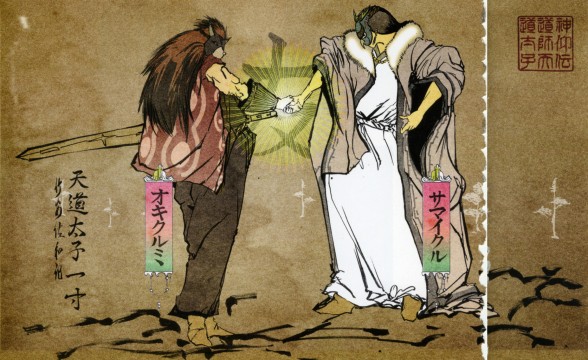
Oki is based on the figure of “Okikurumi,” who has both historical and mythological significance to the Ainu. On the historical side of things, Okikurumi was the Ainu name for the Japanese hero, Minamoto no Yoshitsune. He is the primary hero in many Ainu tales, including many of the oina poems. Incidentally, Minamoto no Yoshitune (whose childhood name was Ushiwakamaru) was also the basis of Waka’s character, making Oki something like the Waka of the North– if such a thing is possible– and Yoshitsune’s main companion in his exploits was none other than Saitō Musashibō Benkei, the basis for our favourite warrior-monk-fisherman enthusiast, Benkei (and it just so happens that one of Okikurumi and Benkei’s tales do in fact concern the fabled sword-fish Benkei was searching for in Sei-an City).
On the mythological side, Okikurumi is a god who is believed to be the father of all the Ainu. Also going by the names of Ainurakkar and Ae-oine Kamui, Okikurumi was the one who first taught the Ainu how to hunt and fish. As their most ancient ancestor and creator, he’s often been given a kind of divine hero status in most of his folktales, making him a god of truly legendary proportions.
It’s rather ironic then that when we first meet Oki he’s portrayed as a wild warrior hungry for blood and demon-slaying, almost blind to Amaterasu’s godliness as he seeks to return his sword Kutone to its former glory. Moreover, he’s stolen Kutone from Wep’keer without permission and has left his friends to fend for themselves. This isn’t a man who seeks to teach others; this time he’s the one in need of guidance to set him back on the straight and narrow, and it’s only through Ammy’s persistence and Shiranui’s great sacrifice that Oki can finally see the error of his ways. In a way it emphasises that the teachings of the gods are still relevant today, but just like Ammy and Susano’s stories in Part I, it also works to reinforce the game’s central idea of teamwork. In Oki’s case, it was his selfish desire for power which was preventing Kutone from glowing silver and reaching its full power, but when he stopped resisting Ammy and Shiranui and accepted their help, he was able to become the hero of his namesake by cutting down Lechku and Nechku in one mighty blow. With Oki, we’re able to see the student become the teacher; we take part in his journey and we’re able to reap the fruits of our labour by seeing him live up to his own legend.
Now closely associated with Oki and the Oina tribe are the Poncle, Issun’s miniature brethren. As I described in Part I, Issun himself is based on the Japanese story of “Issun-bōshi” (One Inch Boy), but the Ainu also have a similar myth about a race of tiny people.
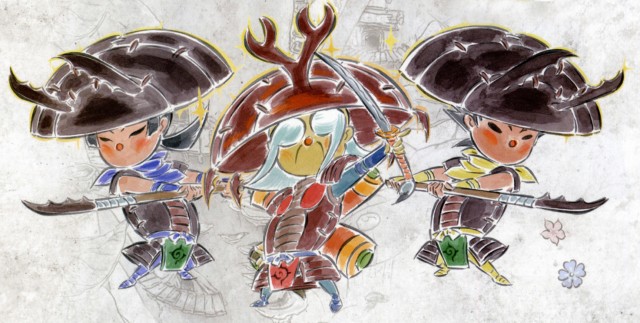
Known as the “Koro-pok-guru,” the Ainu believed that these miniature people were small, agile fishermen who lived in the Ainu’s land before the Ainu themselves settled there, residing in small pits made from butterbur leaves. Koro-pok-guru itself means “people below the leaves of the butterbur plant,” hence the butterbur house tools. The legend goes that long ago the koro-pok-guru were great friends with the Ainu. They would send game, fish, and other gifts to the Ainu and exchange goods with them. However, they would only make their trades at night because they hated being seen. But one day, a young Ainu man was so eager to see one of these illusive koro-pok-guru for himself that he stayed awake to ambush one by the window where they usually left their gifts. When a koro-pok-guru finally came to the window, the young man caught it. He then discovered that he’d caught a beautiful female koro-pok-guru, but she was so enraged at the man’s rudeness that she and her people disappeared for good and never saw the Ainu again. Despite their disappearance though, the Ainu still believe that the koro-pok-guru’s pits, pottery, and stone implements are scattered around their landscape.
In Ōkami, the Poncle village of Ponc’tan is hidden away deep in the “consuming forest” of Yoshpet. Rather than having completely fallen out with the Oina though, the Poncle still seem to have a reasonably casual relationship with them. Similarly, while they may have swapped the fishing rod for a paint brush, they are still producing gifts for the outside world, albeit for a much larger audience than just the Oina. It might sound like a cliché, but the Poncle really do embody the idea of “even the smallest person can make a difference.” By training to become celestial envoys, they scatter their heavenly paintings around the world to keep up the faith in the gods, and their sprite-like size only adds to the sense of mystery and wonder their work creates in the hearts of Nippon’s people.
But threatening both the Poncle and the Oina are Lechku and Nechku, the twin owl demons who rule the roost up in Wawku Shrine, Yami’s final head minions alongside Orochi and Ninetails.
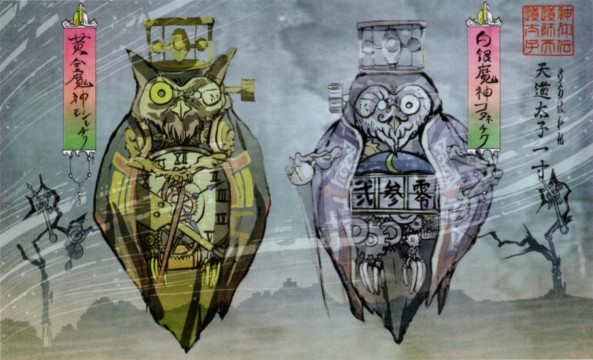
However, the story behind these owls isn’t quite as clear-cut as their evil cohorts– rather, their origins are drawn from a myriad of different sources, some rather more obscure than others, but I shall nevertheless endeavour to draw together the most common lines of thought regarding their shrouded history.
To start, the owl plays an important role in Ainu mythology. The Ainu god of owls and the land, Chikap Kamui (also known as Kotan-Kor Kamui), is often depicted as a great protector and village guardian, making him one of the most significant kamui gods for the Ainu. This is why you can see huge owl totem poles rising up out of the snow in the village of Wep’keer.
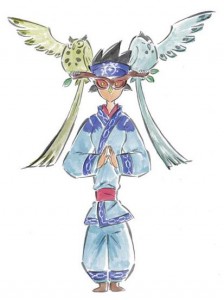 Tuskle, the Oina shaman, also wears a mask with two owls either side of her head. Interestingly, in the tale “Song Sung by the Owl God: Silver Drops Fall, Fall, All Around,” it is said that Chikap Kamui’s tears fall as drops of gold and silver, and this is reflected in both Tuskle’s headdress and Lechku and Nechku’s colour scheme.
Tuskle, the Oina shaman, also wears a mask with two owls either side of her head. Interestingly, in the tale “Song Sung by the Owl God: Silver Drops Fall, Fall, All Around,” it is said that Chikap Kamui’s tears fall as drops of gold and silver, and this is reflected in both Tuskle’s headdress and Lechku and Nechku’s colour scheme.
Yet this sacred god doesn’t exactly sit well with the altogether more sinister nature of our Ōkami duo. However, Chikap Kamui is a specific type of owl– the eagle owl. Other owls, like the little-horned owl and the barn owl, are seen as demons, and Lechku and Nechku hail from these two owl breeds. Despite this though, their relationship with Chikap Kamui doesn’t end there. Although their English names don’t bear any resemblance to the Ainu god, their respective Japanese names– Moshirechiku and Kotanechiku– do in fact share some common ground. In the Ainu language, “moshir” means country and “kotan” means village, harking back to Chikap Kamui as protector of villages and god of the land as well as his alternative name.
You could say that this makes them a kind of inverse Chikap Kamui, a barn owl and little-horned owl masquerading as the godly protector, but the clear references in their names suggest that it’s almost as if Chikap Kamui himself has become corrupted by evil despite the difference in breeds. Other theories suggest that Moshirechiku and Kotanechiku were two specific Ainu demons, though I personally cannot find anything to support this. However, the same theory also states that, according to legend, they once kidnapped Amaterasu, who was in turn rescued by Ae-oine Kamui (aka our hero Okikurumi).
Now this particular version was extremely difficult to verify, but it comes very specifically from the different genres of “oina,” the epic poems about the gods, and the genre of oina in question directly concerns Okikurumi: the “por-oina” (great oina). It tells the story of Okikurumi saving the sun goddess, Chup Kamui, from a devil (although the devil is not named or specified as the two owls). Originally goddess of the moon, Chup Kamui begged her sun god brother to change places with her after witnessing so many illicit midnight trists between the people down below. But when she traded places with her brother to become the sun goddess, Chup Kamui came under threat from a devil who wished to harm the Ainu by swallowing her up and leaving the land in darkness. But Okikurumi helped Chup Kamui escape the devil’s clutches by sending a crow in her place, and thus restored light and peace to the world.
Although the source doesn’t imply that the demons are owls or anything to do with Lechku and Nechku, this myth does tie in very nicely with the imminent Day of Darkness which threatens to destroy Kamui and the inhabitants of Wep’keer (and indeed the whole of Nippon). The once-in-a-hundred-year total solar eclipse would not only freeze Kamui to the bone and wipe out all signs of life, but the darkness would strengthen every demon in the land, allowing Yami to finally rise to power and destroy the world. The battle with Lechku and Nechku is to prevent this from happening (at least in part), and the way Ammy has to launch Oki toward the owls when they’re stunned could also be seen as a throw-back to the legend’s crow.
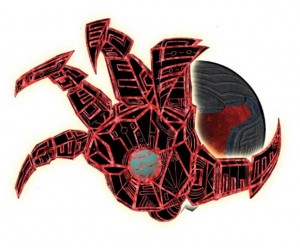 However, it’s likely that the role of the story’s devil ultimately goes to Yami rather than Lechku and Nechku, and it’s here where we have perhaps the game’s biggest narrative hijack. It isn’t Oki that defeats Yami– it’s Ammy, and on this occasion it’s as if she’s commandeered Oki’s legend for herself, completely displacing the Oina warrior and his culture. But for all her sneaky subterfuge, Ammy still can’t do it alone. She needs Oki’s help (and indeed the help and prayers of everyone in Nippon) to help her triumph over evil, and this final fight with Yami once again reinforces the game’s theme of unification between man and beast, god and human. Moreover, it’s almost as if she’s redeeming her own mythic counterpart through her efforts to stop Yami in his tracks– instead of sulking in a cave and letting darkness consume the world, here she is valiantly fighting to save it, even though all hope seems lost when Yami strips her of her celestial powers. Much like Oki, Ammy has evolved the story of her origin by combining Ainu and Japanese folklore together, uniting much more than just the people with the gods in this climactic celebration of narrative and good vs. evil. Instead she’s created her own legend– the legend of Ōkami itself.
However, it’s likely that the role of the story’s devil ultimately goes to Yami rather than Lechku and Nechku, and it’s here where we have perhaps the game’s biggest narrative hijack. It isn’t Oki that defeats Yami– it’s Ammy, and on this occasion it’s as if she’s commandeered Oki’s legend for herself, completely displacing the Oina warrior and his culture. But for all her sneaky subterfuge, Ammy still can’t do it alone. She needs Oki’s help (and indeed the help and prayers of everyone in Nippon) to help her triumph over evil, and this final fight with Yami once again reinforces the game’s theme of unification between man and beast, god and human. Moreover, it’s almost as if she’s redeeming her own mythic counterpart through her efforts to stop Yami in his tracks– instead of sulking in a cave and letting darkness consume the world, here she is valiantly fighting to save it, even though all hope seems lost when Yami strips her of her celestial powers. Much like Oki, Ammy has evolved the story of her origin by combining Ainu and Japanese folklore together, uniting much more than just the people with the gods in this climactic celebration of narrative and good vs. evil. Instead she’s created her own legend– the legend of Ōkami itself.
And as the light wanes on both this trilogy and our final tales of disappearing suns, we’re brought full circle to where it all began. I hope you’ve enjoyed this three-part series about the hidden stories behind one of Wii’s greatest titles, and I hope it’s made for some interesting and insightful reading. It’s certainly helped me see the game in a whole new light, so I hope it’s done the same for you too.




 ShareThis
ShareThis







This is a really fine series – well researched and fascinating. Thank you so much for it. It really adds some unexpected depth to this wonderful game.
Thank you! I’m glad you enjoyed reading them! :)
Hi katharine, i really enjoy your articles, they are insightfull and amusing I readthe first and third. CHapter of this series, but for some reason the link for the second one doesnt work, and i really want to read that article, can you fix this problem or give me the proper link? Take care ;)
Hey lukas85, thank you so much for your comment! I’m so sorry the link didn’t work. Should be all fixed now :) I hope you enjoy it!